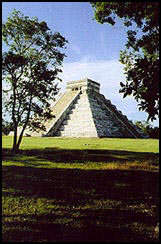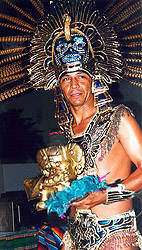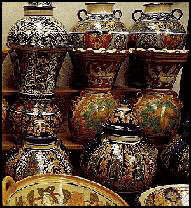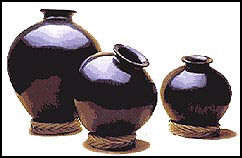 ARTS, PEOPLE AND CULTURE ARTS, PEOPLE AND CULTURE |
 ARTS ARTS |
Millenniums ago, the Maya forged a civilization now considered one of the most important ever to exist in the ancient world. In an extraordinary burst of creativity which lasted around 600 years, the Maya built immense cities, temples and pyramids, created a huge trade network and made breakthroughs in the arts and sciences that placed them leagues ahead of their contemporaries. Then, for reasons unknown, their culture went into decline, cities were abandoned and the inhabitants disappeared.

The areas they reigned - Guatemala, Belize, Honduras, El Salvador and the five Mexican states of Chiapas, Tabasco, Yucatán, Quintana Roo and Campeche - are collectively referred to as the Maya World.
In Central Mexico, some archaeological treasures have been preserved as, among others, the site of the Kukulcan Pyramid in the Yucatan, Chichen-Itza, the pyramids of Teotihuacan, 31 miles northeast of Mexico City (one of the country's most popular tourist attractions), Malinalco that was once a ceremonial center for Aztec warriors and is renowned for its magnificent jaguar and eagle figures carved out in the mountain.
In South Mexico, the Zatopec and Mixtec were parallel cultures that flourished in the Valley of Oaxaca. The magnificent ceremonial centres of Monte Albán and Mitla are a testament to their skill as builders and artists.
In the Gulf Coast, the Pyramid of the Niches is considered one of the ancient world's most beautiful buildings. Finally, northwest of Chihuahua city lies the most important archaeological zone in the north, the ruins of the city of Paquimé.
 PEOPLE AND CULTURE PEOPLE AND CULTURE |

The major ethnic division is between Mestizos (people of mixed ancestry, normally Spanish and Indians as well as few Africans and Europeans) and Indians who are descendants of Mexico's pre-Hispanic inhabitants and have retained their sense of distinct identity. However, the Mexican race experiment was not voluntary. The merging of the Spaniard and the Indian was a product of brute force and domination. Indeed, three centuries of Spanish colonial rule over Mexico (1521 to 1821) have often been described as history's most prolonged and wide-spread example of massive rape.
Mestizos with the few people of supposed pure Spanish descent hold most positions of power in Mexican society.
Some studies showed that Mexico offers more than 139 vanished Indian languages, with about 50 different Indian cultures that have survived.
The Mexican's want to be neither Indian or Spanish. Their rejection of areas of the past is a consequence of a traumatic and unique happenings of history. Present day Mexicans issue largely from the most intense experiment in the mingling of two races in human history: Race has been an important issue and of intense debate so much so that in 1990 the census did not include any reflections and opinions about it. Nevertheless, studies published in the 1980's indicted that 55% of all Mexicans were apparently of mixed race.
The merging of the Spanish and Indian races was
not by chance but pure force. After three centuries
of Spanish colonial rule over Mexico (1521-!821)
which has often been described the longest and harshest
level of human rape. Through the colonial heritage,
Mexicans derive principally from conquistadors and
not as we feel sometimes through inter-racial development.
|
Modern day Mexico is slowly creating an identity of its own. A Country which today represents a long history of change is finding who it is and where it is going. The people are intelligent and educated and if anything, history has served to demonstrate the richness of a culture which continues to fascinate the over.
 PROMOTING MEXICAN CULTURE PROMOTING MEXICAN CULTURE |
As I write of my native country, Mexico, the new millennium has begun.
We are surrounded by technology
Look around and we see the constant advancement of our society
Everywhere we look, we see a lap top, a mobile phone, even a fax
But I can also see a beautiful Talavera vase from a trip made to Puebla
I ease my mind and can still remember
It was a sunny day
How we walked the cobble streets
And chatted at the market stalls
I remember the vivid colours everywhere, in the food, at home, on the walls, in my garden
I relax with the wonderful memories that these objects remind me of.
The Talavera Vase brings me comfort and joy
A moment to breathe
A Moment of reflection, a moment to remember Mexico
It's beautiful, colourful arts and crafts
The unique Talavera vase brings me a little bit of "fiesta" to my daily routine of modern life
Diana Huerta
It's now that I understand why Mexicans were given such sensitive and magical hands. It's as if the powers that we were able to bring beauty even to the most ordinary of objects. Fortunately, 450 years after the conquest, we see the continual survival of Mexican history and tradition. Design and home furnishing has become an integral part of the international vocabulary of style.

Today, I am in the privileged position to be able to bring you a taste of unique Mexican accents to your homes any where in the world and allow you to decorate your homes with the warmth of Mexico that will enhance your surroundings.
Among the many artifacts and items Diana Huerta promotes internationally, you can find:
Tile and Talavera style pottery, unique to the towns of Puebla and Dolores Hidalgo
Wooden spoons and Chocolate mixers, from the State of Mexico
Equipales from Tlaquepaque, Jalisco
Green pottery from Patamban in Michoacan, Jalisco
Deep hand- hammered pots of Copper, from Santa Clara del Cobre, Michoacan
Traditional Zapotec designs in rug of wool, from Teotitlan del Valle, Oaxaca
Religious clay figures from Atzompa, Oaxaca
Black pottery from San Bartolo Coyotepec, Oaxaca
Alebrijes from Coyotepec Oaxaca

For further information, contact:
GATANA, S.A. DE C.V., (export - sales of Mexican artesan and other products)
Lic. Diana Huerta
Phone.: (52) 5652 8678, 5568 2014.
Fax: (52) 5568 2147 Pager: (52) 5227 7979 Pin: 5628300
Email: buymexico@mexis.com
|

